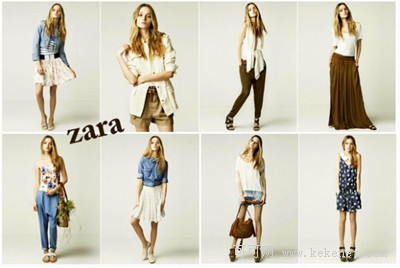
Welcome to the world of Zara, purveyor of mass fashion. Amancio Ortega began making clothes in a rented garage in 1963. Now Zara"s parent, Inditex, a listed company Mr Ortega still 59% owns, has more than 5,000 stores in 77 countries. It is still growing apace, especially in China, where it will open 80 more stores this year.
欢迎来到Zara世界——大众时尚的代言人。Amancio Ortega于1963年开始在一间租来的车库里制作衣服。现在,作为Zara的母公司,已经上市的Inditex公司(Ortega先生仍持有59%的股份)在全球77个国家拥有超过5000家分店。Zara目前仍然飞速发展,尤其在中国。今年Zara计划在中国再开设80多家分店。
The secret of Zara's success is its speed—four weeks for a new fashion idea to hit the shops—and the feedback that store managers send to head office, to help it fine-tune its ideas. There is also firm control from Spain, the sole logistics hub. Although 34% of Inditex's manufacturing is outsourced to Asia, and 14% to parts of Europe including Turkey, those tend to be the more basic items. The high-fashion stuff, 49% of what it sells, is cut and finished in Spain though some sewing is done elsewhere.
Zara的成功之道在于速度——一个新的时尚设计构思只需四周就可以上架销售——同时,专卖店的管理人员将回馈发回总部,帮助进一步完善这一构思。同时,在唯一的物流中心西班牙,公司也实施严格的控制。尽管Inditex34%的生产已经外包给亚洲国家,14%外包给欧洲部分地区包括土耳其,这些外包的产品都是一些基本款。而占公司总销售49%的高端时尚产品则在西班牙进行剪裁并制成成衣,部分缝纫工作在其他地区完成。
Few rivals come close. Hennes & Mauritz (H&M) of Sweden is nearest. It is not as fast to market with new styles—months rather than weeks. But where it has caught on, especially in Germany, the Netherlands and Austria, its market penetration is higher. It has distribution centres dotted around Europe. Some 65% of its product is made in lower-cost countries in Asia. That means its cost base is lower than Inditex’s, but it is more vulnerable to disruptions.
Inditex一枝独秀,罕有匹敌。瑞典的H&M是实力最相近的对手。H&M不似Inditex能够迅速将新时尚产品推向市场——通常需要数月而不是数周来完成。 但是它在一些地区逐渐赶上了Inditex,尤其是德国,荷兰和奥地利。在这些地区,它的市场渗透率高于Inditex.H&M的分销中心遍布欧洲。 而且H&M65%的产品生产在亚洲一些成本更低的国家完成。这使得它的成本来源[1]低于Inditex.但是也更容易遭受干扰。
H&M was late into Asia, which still provides only 3% of revenues. Its January like-for-like sales were up only 1% on January 2010. Inditex, which reports annual results on March 23rd, will probably have done better. A big question, however, is how far it can go on growing from its home base. Now that 15% of its sales are in Asia, does it make sense to run product design and logistics just from Spain? Some clothes it has made in China are shipped to Spain and then back to shops in China. The chief executive, Pablo Isla, sees no need for a second product base: "We're not thinking of replicating the brain in Asia," he says, " though maybe logistics."
H&M进入亚洲较晚,该地区仅占其总收入的3%,今年1月份较2010年1月相比,同比销售额仅增长1%。而将于3月23日发布年度收入报告Inditex,可能略胜一筹。但是,Inditex能在本土之外有多大作为,值得深思。目前,鉴于其15%的销售来自亚洲,把产品设计和物流完全依赖于西班牙是否是明智之举?有些中国生产的服装被运送回西班牙然后又运回的中国专卖店销售。公司首席执行官Pablo Isla 认为没必要再建一个生产基地。他称,“我们目前不会考虑在亚洲另起炉灶,但可能会建立一个物流中心。
Another question is how long Zara can go on charging such markedly varying prices in different countries. Japanese customers pay about half as much again as west Europeans. Luca Solca of Sanford Bernstein, a research firm, says consumers in China, where Zara also charges more, see high prices as part of a product's appeal. But what will happen as Zara expands its online catalogue? H&M, which is further ahead in this, seems to be maintaining its big regional markups. Mr Solca says the 60% price differences Zara maintains between some countries are unsustainable—but 30% may be quite possible.
另一个疑问在于,目前Zara在不同国家,产品定价大相庭径,这一做法还能延续多久?同类产品,日本的顾客要比西欧顾客多付50%的价格。伯恩斯坦调研公司Luca Solca称,在中国,Zara虽然定价也相对较高,但是中国消费者认为高价是产品本身吸引力的元素之一。但是随着Zara品牌走向在线营销,会发生怎样的变化?H&M在差异定价方面走得更远,似乎它将继续保持显著的区域差价。Solca先生称Zara在不同国家间所所维持的60%的差价似乎难以为继——但是30%则很有可能。
注释:
like-for-like sales: 本期销售额中,由与前期相同的销售活动实现的销售量的部分。是在排除本期销售活动变动带来的影响后的同比销售量。
本文关键字: zara
 免费试听
免费试听

时长 : 5:22 主讲 : 金格妃

时长 : 27:51 主讲 : 金格妃

时长 : 17:20 主讲 : 郭宁

时长 : 3:54 主讲 : 金格妃

时长 : 26:58 主讲 : 乔迪

时长 : 26:58 主讲 : 乔迪

时长 : 26:58 主讲 : 乔迪

时长 : 3:54 主讲 : 金格妃

时长 : 1:46 主讲 : 金格妃
 推荐阅读
推荐阅读
在英语学习过程中,通过双语新闻,大家可以多关注最新的新闻时事,让大家更全面的提升英语水平,同时也可以解决大家在英语学习过程中的
来源 : 网络 2024-05-15 08:38:00 关键字 : 双语新闻
在英语学习过程中,通过双语新闻,大家可以多关注最新的新闻时事,让大家更全面的提升英语水平,同时也可以解决大家在英语学习过程中的
来源 : 网络 2024-05-15 08:38:00 关键字 : 双语新闻
在英语学习过程中,通过双语新闻,大家可以多关注最新的新闻时事,让大家更全面的提升英语水平,同时也可以解决大家在英语学习过程中的
来源 : 网络 2024-05-15 08:38:00 关键字 : 双语新闻
在英语学习过程中,通过双语新闻,大家可以多关注最新的新闻时事,让大家更全面的提升英语水平,同时也可以解决大家在英语学习过程中的
来源 : 网络 2024-05-15 08:38:00 关键字 : 双语新闻
在英语学习过程中,通过双语新闻,大家可以多关注最新的新闻时事,让大家更全面的提升英语水平,同时也可以解决大家在英语学习过程中的
来源 : 网络 2024-05-15 08:38:00 关键字 : 双语新闻
在英语学习过程中,通过双语新闻,大家可以多关注最新的新闻时事,让大家更全面的提升英语水平,同时也可以解决大家在英语学习过程中的
来源 : 网络 2024-05-14 08:39:00 关键字 : 双语新闻
在英语学习过程中,通过双语新闻,大家可以多关注最新的新闻时事,让大家更全面的提升英语水平,同时也可以解决大家在英语学习过程中的
来源 : 网络 2024-05-14 08:39:00 关键字 : 双语新闻
在英语学习过程中,通过双语新闻,大家可以多关注最新的新闻时事,让大家更全面的提升英语水平,同时也可以解决大家在英语学习过程中的
来源 : 网络 2024-05-14 08:39:00 关键字 : 双语新闻
在英语学习过程中,通过双语新闻,大家可以多关注最新的新闻时事,让大家更全面的提升英语水平,同时也可以解决大家在英语学习过程中的
来源 : 网络 2024-05-14 08:39:00 关键字 : 双语新闻
在英语学习过程中,通过双语新闻,大家可以多关注最新的新闻时事,让大家更全面的提升英语水平,同时也可以解决大家在英语学习过程中的
来源 : 网络 2024-05-14 08:39:00 关键字 : 双语新闻
